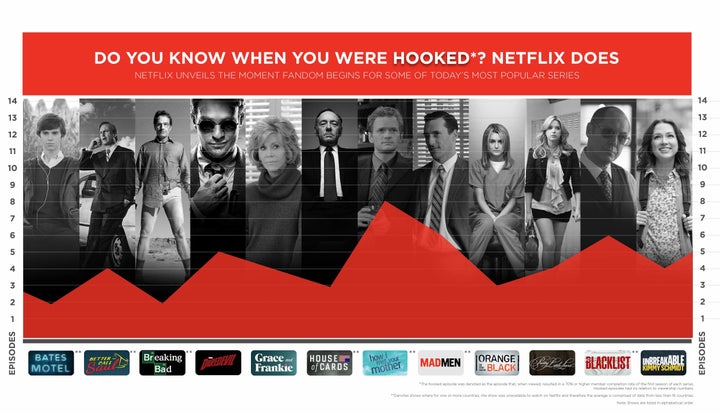
Watching a TV show on Netflix is a little like flying a spaceship near a black hole. You can only be casual about it for so long. If you go too far, you'll eventually encounter a point of no return. Once you cross this threshold, gravity takes hold, and there's nothing you can do to escape. You should just resign yourself to the fact that you're going to end up binge-watching the entire series.
But where exactly is this event horizon? How many episodes of a series do you have to watch before you become hopelessly enmeshed in the world of the show, and compelled to finish it? Netflix recently crunched some data to find out.
The sharing service's analysts were specifically trying to figure how the number of episodes that someone needed to watch to give them a 70 percent chance of finishing the first season. And they discovered that number varies a lot from show to show.
Here's a chart illustrating Netflix's findings:

Among the series the team looked at, the ones that hooked viewers the quickest were "Bates Motel" and "Breaking Bad." It took viewers just two episodes to get on board with these two. The show that took the longest was "How I Met Your Mother" -- at a whopping eight episodes.
A few words of caution, though, about these results: the first seasons of "Bates Motel" and "Breaking Bad" are much shorter, at 10 and seven episodes respectively, than the 22-episode first season of "How I Met Your Mother." So someone who watches two episodes of "Breaking Bad" is already much closer to the end of the season -- and therefore, on the face of it, much more likely to finish it -- than someone who watches two episodes of "How I Met Your Mother."
Still, these results reveal some interesting things about the nature of binge-watching, increasingly the dominant mode of TV viewership. The shows that hooked viewers the quickest were generally those with plots that were highly serial, continued across many episodes, rather than episodic -- meaning they start and end in a single episode. That helps explain why Netflix has tended toward serial plots when producing its own shows.
Indeed, part of what makes these data compelling is that they give a glimpse into the vast array of ways that Netflix can use data to influence its programming decisions. Traditional TV networks would kill for information like this, but there's just no way for them to get it.
Also on HuffPost:

